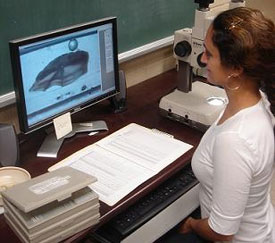Inshore Fisheries Research Section

Ageing Work
Knowing a fish's age, together with other life-history parameters, is of paramount importance because it allows us to establish crucial life-history characteristics for a population.
For example:
- growth rates - the increase in size of a fish per year
- age at sexual maturity
- mortality rates - the rate at which the numbers in a population decrease with time
- fecundity - the potential reproductive output of a female fish determined by how many eggs will be produced per spawning event (or batch fecundity).
- other data attributes.
These data are in turn used in stock assessment models and, ultimately, in the management of the fishery.
Historically, one of the ways a fish's age was determined was by counting growth rings on scales. This method later proved to generate incorrect ages for some species and the use of ear bones or otoliths became the preferred, most accurate, means of determining age. Scales are still used in establishing ages for young fish of some species. This is because when a fish is young, it grows steadily and quickly. However, after a certain point, its growth slows and growth rings on scales appear closer together, making them no longer reliable. Also, older fish have had more time to lose or damage their scales compared to younger fish. Since red drum are a long-lived species and the animals we sample in the estuary are relatively young, we can use scales to age them.
We regularly extract otoliths from spotted seatrout, striped mullet, southern flounder, sheepshead, and black drum. Some of our samples come from fish captured during our regular field efforts, and the rest are provided by anglers participating in our Freezer Fish Program and in Fishing Tournaments. To prepare an otolith for age determination, we make a thin section of it using a low speed diamond saw. Each section is then mounted onto a microscope slide and read under a microscope according to established protocols. Otoliths from southern flounder do not require sectioning and are mounted whole. For more details please see - Using Otoliths to Age Fish.
